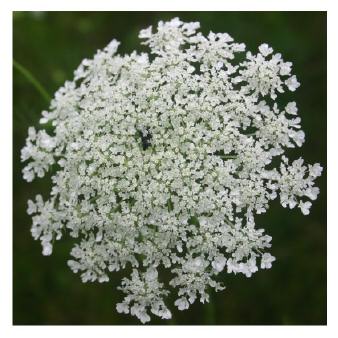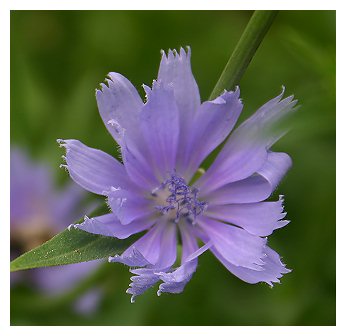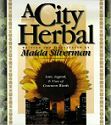THE WILD HERBS OF MY NEW CITY
by Maida Silverman
author of A City Herbal
In November 2004, this lifelong New York City resident
moved to a new city. Milwaukee, Wisconsin is my new home.
Moving to a new environment is, we know, a stressful event.
So, as spring advanced into summer, I went looking for old
friends to help me feel at home here. If, as I do, you count
the wild herbs as your friends, you will never be friendless.
This is especially true when you move to a new and unfamiliar
city---and suburbs and countryside too. You will find the
wild herbs, waiting to welcome and comfort you.
Behind my home, an abandoned railroad track stretches
away for many miles. What treasures I found! The edges of
the park and the abandoned tracks were a wild garden in
the city--I found many wild herbs growing there. I am fortunate
to live across the street from a park that borders the beautiful
Milwaukee River. Fields and woodlands are very near.
I looked for old friends and found them. Spring brought
dandelions, and I enjoyed picking the very young leaves
for salads, and added shreds of the yellow flowers for color.
I found lamb's quarters to cook with garlic and oil, and
plantain and yarrow to add to a soothing bath.
 There
were some surprises. I found very little mugwort and no
Japanese Knotweed---both are widespread in New York City.
But motherwort, rare there, is plentiful here. Daisies form
large beds along roadsides, mullein and sumach grow there,
too.
There
were some surprises. I found very little mugwort and no
Japanese Knotweed---both are widespread in New York City.
But motherwort, rare there, is plentiful here. Daisies form
large beds along roadsides, mullein and sumach grow there,
too.
Bittersweet is here, its vines and starry blue flowers
pretty among butter-and-eggs, Queen Anne's lace and chicory.
All are at home along the old rail tracks. Sweet melilot
grows everywhere. The hot midwestern sun brings out its
aromatic, vanilla- like fragrance.
Wild black raspberries, wild grapes and elder are three
new friends I've found here, and good friends they will
be. This morning I walked along the parkside, across the
street from my home, to. greet them. Black raspberries grow
abundantly there, ripe for the picking. So do wild grapes,
draped across the shrubs and trees. Young grapes, small
and green now, are a promise of fall riches.
I was delighted to renew my acquaintance with tansy and
catmint. I never found them in New York City, but first
encountered them in Maine. I¹ve picked large bunches
of sweetly pungent, aromatic tansy, with its cheerful yellow
button-like flowers, to hang up on my patio as a natural
insect repellent. Tall stems of fresh-cut tansy make a dramatic
indoor bouquet and sweetens the air. Dried leaves and flower
sprigs are a fragrant addition to potpourri.
Catmint grows everywhere here, and is not just for cats!
Of course I gathered and dried some to make treats for my
daughter's and grandchildren's beloved pet. I also laid
in a supply for myself. Catmint is excellent for afternoon
tea. I pour not quite boiling water over two teaspoons of
dried leaves and steep it for five minutes. Honey and a
slice of lemon are nice to add. I'm planning to try it iced,
on a hot summer day.
 A
lovely elder bush guards an entrance path to the park. The
delicate white flowers are just starting to open. I will
return with a basket to collect the flat white flowerheads,
and make elder flower fritters for breakfast. I¹ll
add some elder flowers to witch hazel from the drugstore,
for an excellent skin tonic that¹s also soothing for
insect bites.
A
lovely elder bush guards an entrance path to the park. The
delicate white flowers are just starting to open. I will
return with a basket to collect the flat white flowerheads,
and make elder flower fritters for breakfast. I¹ll
add some elder flowers to witch hazel from the drugstore,
for an excellent skin tonic that¹s also soothing for
insect bites.
I've found dock, a favorite of mine--a wild herb of so
many uses. But the biggest surprise was Burdock. It is very
common here and grows at the edges of parks, fields and
woods, where its large, ruffle-edged leaves are quite decorative.
Right now, the branched, flowering stalks are rising up,
tall and dramatic. Looking carefully, I was able to find
very small young burdock plants, and I dug out the still
slender (and easy to remove) edible roots.
I have to be careful, though. Poison Ivy--not a friend!--
grows here, too, and it's more dangerous here than in New
York City. There, poison ivy almost always has very shiny
leaves, and this makes them conspicuous. Here, poison ivy
leaves are just plain green. They blend well with other
leafy plants and are very easy to overlook.So I always make
a point of looking carefully for it when I forage for wild
herbs and berries.
Field and nodding thistle are common in fields here and
must be treated with respect. The needle- sharp points on
leaves and stems make for very painful encounters when foraging.
This is particularly true of the small first-year rosettes
that lurk in the grass. Long pants, sturdy shoes and thick
socks are a must!
I'll be able to gather wild black raspberries for another
week or so.I'll pick the tender leaves from the tips of
the branches and dry them. Raspberry leaves will make a
welcome tea to ease a winter cold or sore throat. In a few
weeks, I'll harvest the winy, purple Elderberries and prepare
Elderberry syrup: A few spoonfuls added to a pitcher
of ice water makes a refreshing summer drink. Of course,
I'll ask permission of the Elder Tree Mother to gather her
bounty, and I'll thank her.
copyright© by Maida Silverman, 2005

Maida Silverman is author/illustrator of "A City
Herbal" reprinted by Wise Woman Bookshop. It can be ordered by at our Bookshop.
Lore, legends, uses and recipes for many of the wild herbs
mentioned in this article can be found in her book.

 There
were some surprises. I found very little mugwort and no
Japanese Knotweed---both are widespread in New York City.
But motherwort, rare there, is plentiful here. Daisies form
large beds along roadsides, mullein and sumach grow there,
too.
There
were some surprises. I found very little mugwort and no
Japanese Knotweed---both are widespread in New York City.
But motherwort, rare there, is plentiful here. Daisies form
large beds along roadsides, mullein and sumach grow there,
too. A
lovely elder bush guards an entrance path to the park. The
delicate white flowers are just starting to open. I will
return with a basket to collect the flat white flowerheads,
and make elder flower fritters for breakfast. I¹ll
add some elder flowers to witch hazel from the drugstore,
for an excellent skin tonic that¹s also soothing for
insect bites.
A
lovely elder bush guards an entrance path to the park. The
delicate white flowers are just starting to open. I will
return with a basket to collect the flat white flowerheads,
and make elder flower fritters for breakfast. I¹ll
add some elder flowers to witch hazel from the drugstore,
for an excellent skin tonic that¹s also soothing for
insect bites.
 Study
with Susun Weed in the convenience of your home! Choose from
four Correspondence Courses: Green Allies, Spirit & Practice
of the Wise Woman Tradition, Green Witch, and
Study
with Susun Weed in the convenience of your home! Choose from
four Correspondence Courses: Green Allies, Spirit & Practice
of the Wise Woman Tradition, Green Witch, and 
